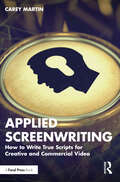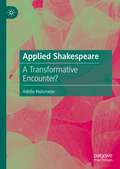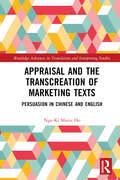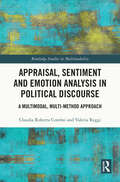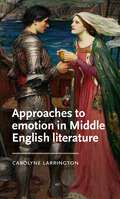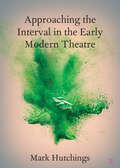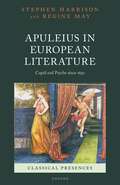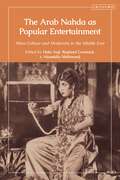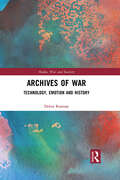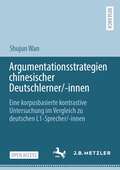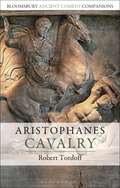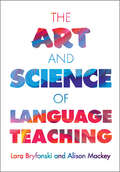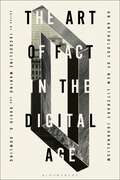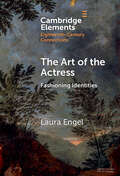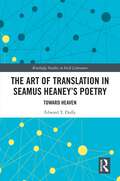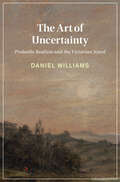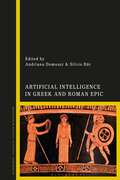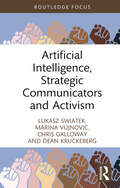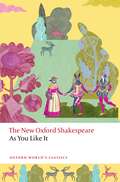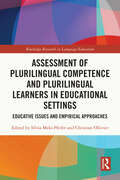- Table View
- List View
Applied Screenwriting: How to Write True Scripts for Creative and Commercial Video
by Carey MartinPutting a vision on the page for creative and commercial video is harder than it seems, but author Carey Martin explains how to bring these tools to bear in the “work for hire” environment. Whilst other texts focus on writing the next award winner, this can be out of reach both logistically and financially for many. Instead, readers will learn how to write what they want the eyes of the audience to see and the ears of the audience to hear, in such a way that the Producer and Director can read the creative blueprint and bring that vision to life. The text will walk readers through a focused and practical consideration of the camera, the edit, and the sound design, in addition to a straightforward application of basic story principles. By understanding writing for video as more than creating a recorded play, readers will become more effective screenwriters and, should they wish, Producers and Directors as well. This book is ideal for students of screenwriting and those writing scripts for message-driven video for corporate, nonprofit, and commercial production.
Applied Shakespeare: A Transformative Encounter?
by Adelle HulsmeierThis book speaks to those interested in where and why Shakespeare’s work is used to capture the transformative intentions of different areas of Applied Theatre practice (Prison, Disability, Therapy), representing a foundational study which considers subsequent histories and potential challenges when engaging with Shakespeare’s work. This is grounded in a case study analysis of three salient British Theatre Companies: The Education Shakespeare Company (prison), the Blue Apple Theatre Company (Disability), and the Combat Veteran Players (therapy).
Appraisal and the Transcreation of Marketing Texts: Persuasion in Chinese and English (Routledge Advances in Translation and Interpreting Studies)
by Nga-Ki Mavis HoThis book contributes to growing debates on transcreation, applying an appraisal framework to texts from luxury brands in Chinese and English to reveal new insights into marketing transcreation and set out transcreation as an area of study in its own right. The volume charts the origins of the term "transcreation", emerging from the interplay of established concepts of translation, creation, localisation, and adaptation and ongoing debates on what should be transcreated and how. Using these dialogues as a point of departure, Ho outlines a way forward for transcreation research by advocating for the use of an appraisal framework, taken from work in systemic functional linguistics and employed to evaluate persuasion in language. In focusing on marketing texts from the websites of three luxury brands in English and Chinese, the book explores how this approach can surface fresh perspectives on the different ways in which the processes and practices of marketing transcreation are used to generate persuasion across languages. The volume looks ahead to the implications for other language pairs and the applications of the appraisal framework to understand transcreation practice of other genres, such as literary texts. This book will be of interest to students and scholars in translation studies and marketing studies.
Appraisal, Sentiment and Emotion Analysis in Political Discourse: A Multimodal, Multi-method Approach (Routledge Studies in Multimodality)
by Claudia Roberta Combei Valeria ReggiThis book adopts a multi-method multimodal approach to the study of online political communication, applying it to case studies from the UK, France, and Italy toward offering a portrait of the rapid ideological shifts in contemporary Western democracies. The volume introduces an integrated framework combining Sentiment and Emotion Analysis, rooted in lexical semantics, and the qualitative dimensions of Appraisal Theory, applying it to large corpora of online political communication from the UK, France, and Italy. Combei and Reggi highlight their combined potential in analyzing the multimodal resources in such discourses and in turn, revealing fresh insights into layers of subtext and the ways in which parties and movements frame their political programmes and values. The authors also take into account culture- and language-specific variables across the three countries in shaping such discourses. The volume makes the case for an integrated methodological framework that can be uniquely applied to better understand the multimodal communicative landscape of divisiveness in today’s rapidly shifting political climate and other forms of online communication more broadly. This book will be of interest to students and scholars in digital communication, political communication, multimodality, and qualitative and quantitative discourse analysis, especially those interested in corpus-assisted approaches.
Appraisal, Sentiment and Emotion Analysis in Political Discourse: A Multimodal, Multi-method Approach (Routledge Studies in Multimodality)
by Claudia Roberta Combei Valeria ReggiThis book adopts a multi-method multimodal approach to the study of online political communication, applying it to case studies from the UK, France, and Italy toward offering a portrait of the rapid ideological shifts in contemporary Western democracies. The volume introduces an integrated framework combining Sentiment and Emotion Analysis, rooted in lexical semantics, and the qualitative dimensions of Appraisal Theory, applying it to large corpora of online political communication from the UK, France, and Italy. Combei and Reggi highlight their combined potential in analyzing the multimodal resources in such discourses and in turn, revealing fresh insights into layers of subtext and the ways in which parties and movements frame their political programmes and values. The authors also take into account culture- and language-specific variables across the three countries in shaping such discourses. The volume makes the case for an integrated methodological framework that can be uniquely applied to better understand the multimodal communicative landscape of divisiveness in today’s rapidly shifting political climate and other forms of online communication more broadly. This book will be of interest to students and scholars in digital communication, political communication, multimodality, and qualitative and quantitative discourse analysis, especially those interested in corpus-assisted approaches.
Approaches to emotion in Middle English literature (Manchester Medieval Literature and Culture)
by Carolyne LarringtonOver the last twenty-five years, the ‘history of emotion’ field has become one of the most dynamic and productive areas for humanities research. This designation, and the marked leadership of historians in the field, has had the unlooked-for consequence of sidelining literature — in particular secular literature — as evidence-source and object of emotion study. Secular literature, whether fable, novel, fantasy or romance, has been understood as prone to exaggeration, hyperbole, and thus as an unreliable indicator of the emotions of the past.The aim of this book is to decentre history of emotion research and asks new questions, ones that can be answered by literary scholars, using literary texts as sources: how do literary texts understand and depict emotion and, crucially, how do they generate emotion in their audiences — those who read them or hear them read or performed?
Approaches to emotion in Middle English literature (Manchester Medieval Literature and Culture)
by Carolyne LarringtonOver the last twenty-five years, the ‘history of emotion’ field has become one of the most dynamic and productive areas for humanities research. This designation, and the marked leadership of historians in the field, has had the unlooked-for consequence of sidelining literature — in particular secular literature — as evidence-source and object of emotion study. Secular literature, whether fable, novel, fantasy or romance, has been understood as prone to exaggeration, hyperbole, and thus as an unreliable indicator of the emotions of the past.The aim of this book is to decentre history of emotion research and asks new questions, ones that can be answered by literary scholars, using literary texts as sources: how do literary texts understand and depict emotion and, crucially, how do they generate emotion in their audiences — those who read them or hear them read or performed?
Approaching the Interval in the Early Modern Theatre: The Significance of the 'Act-Time' (Elements in Shakespeare Performance)
by null Mark HutchingsIn requiring artificial light, the early modern indoor theatre had to interrupt the action so that the candles could be attended to, if necessary. The origin of the five-act, four-interval play was not classical drama but candle technology. This Element explores the implications of this aspect of playmaking. Drawing on evidence in surviving texts it explores how the interval affected composition and stagecraft, how it provided opportunities for stage-sitters, and how amphitheatre plays were converted for indoor performance (and vice versa). Recovering the interval yields new insights into familiar texts and brings into the foreground interesting examples of how the interval functioned in lesser-known plays. This Element concludes with a discussion of how this aspect of theatre might feed into the debate over the King's Men's repertory management in its Globe-Blackfriars years and sets out the wider implications for both the modern theatre and the academy.
Apuleius in European Literature: Cupid and Psyche since 1650 (Classical Presences)
by Stephen Harrison Regine MayThe story of Cupid and Psyche is first known through the Latin novel Metamorphoses or The Golden Ass by the second-century AD writer Apuleius—one of the few Latin fictions from Roman antiquity to have survived in its entirety. Apuleius in European Literature: Cupid and Psyche since 1650 examines the reception of the long two-book romantic story of Cupid and Psyche in European literature from 1650 to the present day, with some attention also devoted to fine art and opera across this period. Stephen Harrison and Regine May argue that Cupid and Psyche had a broad and profound influence on certain important and specific areas of European culture; it was appropriated and adapted to suit particular cultural and generic contexts, especially the development of the fairy tale. This constitutes an important strand of the more general reception of the ancient novel, since the tale of Cupid and Psyche is arguably the most famous section of any fiction from Greece or Rome. Apuleius' story has enjoyed an extraordinarily rich reception throughout the five centuries from its rediscovery in the Renaissance to the present day. Previous studies of this reception have focused on the tale's prominence in Renaissance art and literature, or otherwise on its status in the German Romantic period. This book goes further and wider, ranging across literary genres in English, French, German and Dutch, encompassing poetry and drama as well as prose fiction, and covering all the key elements of the tale's reception from 1650 to the present. We hereby rediscover a tale that today remains as relevant and ripe for appropriation as ever.
The Arab Nahda as Popular Entertainment: Mass Culture and Modernity in the Middle East
by Hala Auji Raphael Cormack Alaaeldin MahmoudWhat was popular entertainment like for everyday Arab societies in Middle Eastern cities during the long nineteenth century? In what ways did café culture, theatre, illustrated periodicals, cinema, cabarets, and festivals serve as key forms of popular entertainment for Arabic-speaking audiences, many of whom were uneducated and striving to contend with modernity's anxiety-inducing realities? Studies on the 19th to mid-20th century's transformative cultural movement known as the Arab nahda (renaissance), have largely focussed on concerns with nationalism, secularism, and language, often told from the perspective of privileged groups. Highlighting overlooked aspects of this movement, this book shifts the focus away from elite circles to quotidian audiences. Its ten contributions range in scope, from music and visual media to theatre and popular fiction. Paying special attention to networks of movement and exchange across Arab societies in Lebanon, Syria, Egypt, Iraq, and Morocco, this book heeds the call for 'translocal/transnational' cultural histories, while contributing to timely global studies on gender, sexuality, and morality. Focusing on the often-marginalized frequenters of cafés, artist studios, cinemas, nightclubs, and the streets, it expands the remit of who participated in the nahda and how they did.
Archives of War: Technology, Emotion and History (Media, War and Security)
by Debra RamsayThis book offers a comparative analysis of British Army Unit War Diaries in the two World Wars, to reveal the role played by previously unnoticed technologies in shaping the archival records of war. Despite thriving scholarship on the history of war, the history of Operational Record Keeping in the British Army remains unexplored. Since World War I, the British Army has maintained daily records of its operations. These records, Unit War Diaries, are the first official draft of events on the battlefield. They are vital for the army’s operational effectiveness and fundamental to the histories of British conflict, yet the material history of their own production and development has been widely ignored. This book is the first to consider Unit War Diaries as mediated, material artefacts with their own history. Through a unique comparative analysis of the Unit War Diaries of the First and Second World Wars, this book uncovers the mediated processes involved in the practice of operational reporting and reveals how hidden technologies and ideologies have shaped the official record of warfare. Tracking the records into The National Archives in Kew, where they are now held, the book interrogates how they are re-presented and re-interpreted through the archive. It investigates how the individuals, institutions and technologies involved in the production and uses of unit diaries from battlefield to archive have influenced how modern war is understood and, more importantly, waged. This book will be of much interest to students of media and communication studies, military history, archive studies and British history.
Archives of War: Technology, Emotion and History (Media, War and Security)
by Debra RamsayThis book offers a comparative analysis of British Army Unit War Diaries in the two World Wars, to reveal the role played by previously unnoticed technologies in shaping the archival records of war. Despite thriving scholarship on the history of war, the history of Operational Record Keeping in the British Army remains unexplored. Since World War I, the British Army has maintained daily records of its operations. These records, Unit War Diaries, are the first official draft of events on the battlefield. They are vital for the army’s operational effectiveness and fundamental to the histories of British conflict, yet the material history of their own production and development has been widely ignored. This book is the first to consider Unit War Diaries as mediated, material artefacts with their own history. Through a unique comparative analysis of the Unit War Diaries of the First and Second World Wars, this book uncovers the mediated processes involved in the practice of operational reporting and reveals how hidden technologies and ideologies have shaped the official record of warfare. Tracking the records into The National Archives in Kew, where they are now held, the book interrogates how they are re-presented and re-interpreted through the archive. It investigates how the individuals, institutions and technologies involved in the production and uses of unit diaries from battlefield to archive have influenced how modern war is understood and, more importantly, waged. This book will be of much interest to students of media and communication studies, military history, archive studies and British history.
Argumentationsstrategien chinesischer Deutschlerner/-innen: Eine korpusbasierte kontrastive Untersuchung im Vergleich zu deutschen L1-Sprecher/-innen
by Shujun WanDieses Open-Access Buch versucht, die Frage warum sich L1- und L2-Texte meistens leicht voneinander unterscheiden lassen, selbst wenn keine sprachlichen Fehler vorhanden sind, am Beispiel von chinesischen fortgeschrittenen Deutschlerner/-innen und deutschen L1-Sprecher/-innen zu beantworten. Basierend auf 40 argumentativen Korpustexten fokussiert sich die Studie auf drei Fragen: a) Wie unterscheiden sich die L1- und L2-Texte im rhetorischen Aufbau? b) Wie werden die Textregionen Einleitung, Hauptteil sowie Schluss von den Vergleichsgruppen jeweils inhaltlich, strukturell und sprachlich gestaltet? Und c) welche Einflussfaktoren könnten die ermittelten Unterschiede/Gemeinsamkeiten bedingen? Zur Erforschung dieser Fragen werden die Korpusdaten anhand der Rhetorical Structure Theory annotiert und anschließend quantitativ sowie qualitativ analysiert. Diese kontrastive Arbeit zeigt ein konkretes Beispiel für eine tiefergehende korpuslinguistische Analyse auf der Diskursebene, was einen wertvollen Beitrag für Forschungen im Bereich des Spracherwerbs und der Textlinguistik leisten kann. Die Erkenntnisse aus dieser Studie bieten einen weiteren Einblick in die Diskursmerkmale der L1- und L2-Texte und können verwendet werden, um die didaktischen Ansätze im chinesischen DaF-Unterricht zu fördern.
Aristophanes: Cavalry (Bloomsbury Ancient Comedy Companions)
by Professor Robert TordoffOffering for the first time a student introduction to Aristophanes' most explosive political satire, this volume is an essential guide to the context, themes and later reception of Cavalry. The ancient comedy is a fascinating insight into demagoguery and political rhetoric in classical Athens. These are subjects that resonate with a modern audience more now than ever before.Originally performed in 424 BCE, Cavalry was the first play Aristophanes directed himself and it was awarded first prize. It targets the Athenian demagogue, Cleon, who had risen to prominence since the death of Pericles and to pre-eminence after an audacious victory over Sparta in 425 BCE. In Cavalry, Aristophanes attacks Cleon's popularity with the masses, but also criticises the democracy itself as guilty of gullibility, self-interest and political shortsightedness. As the play shows, the only hope of escape from the crisis is for Athens to find a leader even more popular Cleon. And who better to be more foul-mouthed, depraved and shameless than a sausage-seller, if only because he turns out in the end to have a good heart and a true love of traditional Athenian values?
The Art and Science of Language Teaching
by Lara Bryfonski Alison MackeyThis user-friendly book is designed for language teachers of all levels and languages who seek to inform their classroom practices with current research findings on second language acquisition. Ideal for courses on second language learning and teaching, teacher reading groups, and professional development workshops, each chapter begins with a story of a real teaching scenario and a concise summary of what cutting-edge language teaching research says (and what it does not say) about the topic. Throughout the twenty-one chapters, the authors connect language research to the classroom, challenge misunderstandings around language pedagogy, and provide solutions. Each chapter concludes with classroom activities, and instructional strategies that can be used immediately in professional development workshops or in the classroom. Additional resources are available online to supplement the activities found in the book. Applicable across all languages and levels, this book is suitable for teachers of diverse backgrounds teaching in diverse contexts.
The Art of Fact in the Digital Age: An Anthology of New Literary Journalism
by Jacqueline Marino and David O. DowlingThe Art of Fact in the Digital Age is a showcase of the most powerful and moving journalism of the past 25 years. Selections include stories originally published in established bastions of literary journalism (The New York Times, The Atlantic and The New Yorker), as well as those from specialized and online publications (Runner's World, The Atavist). It features writers of extraordinary style (including Carina del Valle Schorske, Brian Phillips, and Jia Tolentino), as well as those who have profoundly influenced public discourse on the 21st century's most urgent issues: Mitchell S. Jackson, Clint Smith, and Ta-Nehisi Coates on race; Susan Dominus and Luke Mogelson on migration; and Kathryn Schulz and David Wallace-Wells on environmental threats. It even includes one story that expanded literary journalism's repertoire into audio (This American Life). This collection, assembled for students, scholars, and practitioners alike, also charts the evolution of digital longform journalism through its greatest achievements, from transitioning readers to screens to the integration of multimedia with words in service of meaning. The art of fact in the 21st century opened new ranges of expression to address such issues, while uniquely bearing the imprint of their generation's digital cultures and technologies. Although many forces compete for attention in the digital age, story triumphs. The works in this anthology show us why.
The Art of the Actress: Fashioning Identities (Elements in Eighteenth-Century Connections)
by null Laura EngelThis Element looks at the art of the actress in the eighteenth century. It considers how visual materials across genres, such as prints, portraits, sculpture, costumes, and accessories, contribute to the understanding of the nuances of female celebrity, fame, notoriety, and scandal. The 'art' of the actress refers to the actress represented in visual art, as well as to the actress's labor and skill in making art ephemerally through performance and tangibly through objects. Moving away from the concept of the 'actress as muse,' a relationship that privileges the role of the male artist over the inspirational subject, the author focuses instead on the varied significance of representations, reproductions, and re-animations of actresses, female artists, and theatrical women across media. Via case studies, the Element explores how the archive charts both a familiar and at times unknown narrative about female performers of the past.
The Art of Translation in Seamus Heaney’s Poetry: Toward Heaven (Routledge Studies in Irish Literature)
by Edward T. DuffyThe Art of Translation in Seamus Heaney’s Poetry is a critical study of the poet's later work. While exploring his practice as a translator, it also traces his increasing preoccupation with the possibilities and conditions of translation in the theological sense of being lifted up in spirit. To the work of this philosophical poet, who would be both “earthed and heady” this book brings the insights of ordinary language philosophy as practiced by Stanley Cavell. It devotes separate chapters to Station Island and three later collections: Seeing Things, Electric Light and Human Chain. The first of these addresses the most fundamental change in Heaney’s life when he acknowledges the “need and chance to re-envisage” his Irish-Catholic upbringing; it is also replete with both the activity and the trope of translation. Published seven years later, Seeing Things begins with a translation of Virgil’s golden bough episode and ends with a similar crossing over into the underworld by Dante. Heaney transforms both into poems about poetry. In Electric Light, Heaney returns to Virgil, but now he concentrates not on the hero of the Aeneid but on Virgil's earlier efforts in pastoral, a mode of writing that Heaney takes as a model for his own time and place of “devastated order.” Heaney returns to the Aeneid in Human Chain, but this time around he gives all his attention to the scene of the human souls in Elysium seeking rebirth and turns it into an image for the need and chance of pronouncing “a final Yes” to our world and our place in it.
The Art of Translation in Seamus Heaney’s Poetry: Toward Heaven (Routledge Studies in Irish Literature)
by Edward T. DuffyThe Art of Translation in Seamus Heaney’s Poetry is a critical study of the poet's later work. While exploring his practice as a translator, it also traces his increasing preoccupation with the possibilities and conditions of translation in the theological sense of being lifted up in spirit. To the work of this philosophical poet, who would be both “earthed and heady” this book brings the insights of ordinary language philosophy as practiced by Stanley Cavell. It devotes separate chapters to Station Island and three later collections: Seeing Things, Electric Light and Human Chain. The first of these addresses the most fundamental change in Heaney’s life when he acknowledges the “need and chance to re-envisage” his Irish-Catholic upbringing; it is also replete with both the activity and the trope of translation. Published seven years later, Seeing Things begins with a translation of Virgil’s golden bough episode and ends with a similar crossing over into the underworld by Dante. Heaney transforms both into poems about poetry. In Electric Light, Heaney returns to Virgil, but now he concentrates not on the hero of the Aeneid but on Virgil's earlier efforts in pastoral, a mode of writing that Heaney takes as a model for his own time and place of “devastated order.” Heaney returns to the Aeneid in Human Chain, but this time around he gives all his attention to the scene of the human souls in Elysium seeking rebirth and turns it into an image for the need and chance of pronouncing “a final Yes” to our world and our place in it.
The Art of Uncertainty: Probable Realism and the Victorian Novel (Cambridge Studies in Nineteenth-Century Literature and Culture)
by null Daniel WilliamsThe Victorian novel developed unique forms of reasoning under uncertainty-of thinking, judging, and acting in the face of partial knowledge and unclear outcome. George Eliot, Wilkie Collins, William Thackeray, Thomas Hardy, and later Joseph Conrad drew on science, mathematics, philosophy, and the law to articulate a phenomenology of uncertainty against emergent models of prediction and decision-making. In imaginative explorations of unsure reasoning, hesitant judgment, and makeshift action, these novelists cultivated distinctive responses to uncertainty as intellectual concern and cultural disposition, participating in the knowledge work of an era shaped by numerical approaches to the future. Reading for uncertainty yields a rich account of the dynamics of thinking and acting, a fresh understanding of realism as a genre of the probable, and a vision of literary-critical judgment as provisional and open-ended. Daniel Williams spotlights the value of literary art in a present marked by models and technologies of prediction.
Artificial Intelligence in Greek and Roman Epic
by Andriana Domouzi and Silvio BärThis is the first scholarly exploration of concepts and representations of Artificial Intelligence in ancient Greek and Roman epic, including their reception in later literature and culture. Contributors look at how Hesiod, Homer, Apollonius of Rhodes, Moschus, Ovid and Valerius Flaccus crafted the first literary concepts concerned with automata and the quest for artificial life, as well as technological intervention improving human life.Parts one and two consider, respectively, archaic Greek, and Hellenistic and Roman, epics. Contributors explore the representations of Pandora in Hesiod, and Homeric automata such as Hephaestus' wheeled tripods, the Phaeacian king Alcinous' golden and silver guard dogs, and even the Trojan Horse. Later examples cover Artificial Intelligence and automation (including Talos) in the Argonautica of Apollonius and Valerius Flaccus, and Pygmalion's ivory woman in Ovid's Metamorphoses. Part three underlines how these concepts benefit from analysis of the ekphrasis device, within which they often feature. These chapters investigate the cyborg potential of the epic hero and the literary implications of ancient technology. Moving into contemporary examples, the final chapters consider the reception of ancient literary Artificial Intelligence in contemporary film and literature, such as the Czech science-fiction epic Starvoyage, or Small Cosmic Odyssey by Jan Kr?esadlo (1995) and the British science-fiction novel The Holy Machine by Chris Beckett (2004).
Artificial Intelligence, Strategic Communicators and Activism (Global PR Insights)
by Lukasz Swiatek Marina Vujnovic Chris Galloway Dean KruckebergIn a world that is increasingly wary of artificial intelligence (AI), this book explores the pressing need for strategic communicators to move away from being advocates for AI and move towards a more critical activist role that enables them to counter AI-driven threats to communities and relationships. AI is contributing to inequality, misinformation and environmental damage, among other problems. This book argues that strategic communicators are uniquely placed to help counter AI-driven challenges because of their skills in relationship-building and their ability to craft and deliver messages effectively. By discussing the different professional activist approaches that communicators can take in relation to growing AI challenges, the book offers multiple perspectives that will help to build knowledge in diverse settings and develop practice, especially in community and activist strategic communication. Research-based and combining theory with practice, this thought-provoking book will be welcomed by strategic communication scholars and practitioners alike eager to develop a critical approach to the challenges surrounding AI.
Artificial Intelligence, Strategic Communicators and Activism (Global PR Insights)
by Lukasz Swiatek Marina Vujnovic Chris Galloway Dean KruckebergIn a world that is increasingly wary of artificial intelligence (AI), this book explores the pressing need for strategic communicators to move away from being advocates for AI and move towards a more critical activist role that enables them to counter AI-driven threats to communities and relationships. AI is contributing to inequality, misinformation and environmental damage, among other problems. This book argues that strategic communicators are uniquely placed to help counter AI-driven challenges because of their skills in relationship-building and their ability to craft and deliver messages effectively. By discussing the different professional activist approaches that communicators can take in relation to growing AI challenges, the book offers multiple perspectives that will help to build knowledge in diverse settings and develop practice, especially in community and activist strategic communication. Research-based and combining theory with practice, this thought-provoking book will be welcomed by strategic communication scholars and practitioners alike eager to develop a critical approach to the challenges surrounding AI.
As You Like It: The New Oxford Shakespeare (Oxford World's Classics)
by William Shakespeare'We that are true lovers run into strange capers.' Four centuries after its publication in the Folio, As You Like It's capacity to entertain and instruct remains evergreen. This edition provides a friendly yet authoritative introduction to the play, upholding it as a crowning expression of the Elizabethan Renaissance while underscoring its appeal to twenty-first century readers as Shakespeare's most intrepid exploration of gender, sexuality, and the environment. Its double-cross-dressed heroine dominates the plot (and their love interest Orlando) to conduct a masterclass in gender fluidity. The melancholic Jaques unmasks the fundamental theatricality of existence and questions humanity's prerogative to displace and harm other species. Through the clown Touchstone, the comedy tests the possibility that we might laugh ourselves wise, especially when we learn to laugh at ourselves. In the Forest of Arden, we encounter Shakespeare's most beguiling vision of the natural world as a realm of serenity and harmony, while brushing up against the briars that puncture our fantasies of the simple life. The New Oxford Shakespeare offers authoritative editions of Shakespeare's works with introductory materials designed to encourage new interpretations of the plays and poems. Using the text from the landmark The New Oxford Shakespeare Complete Works: Modern Critical Edition, these volumes offer readers the latest thinking on the authentic texts (collated from all surviving original versions of Shakespeare's work) alongside innovative introductions from leading scholars. The texts are accompanied by a comprehensive set of critical apparatus to give readers the best resources to help understand and enjoy Shakespeare's work. ABOUT THE SERIES: For over 100 years Oxford World's Classics has made available the widest range of literature from around the globe. Each affordable volume reflects Oxford's commitment to scholarship, providing the most accurate text plus a wealth of other valuable features, including expert introductions by leading authorities, helpful notes to clarify the text, up-to-date bibliographies for further study, and much more.
Assessment of Plurilingual Competence and Plurilingual Learners in Educational Settings: Educative Issues and Empirical Approaches (Routledge Research in Language Education)
by Silvia Melo-Pfeifer Christian OllivierThis book addresses contemporary issues in the assessment of plurilingual competence and plurilingual learners. Offering theoretical and practical lenses, it contributes towards an integrated and holistic assessment of plurilingual competence and plurilingual learners. The book provides both theoretical considerations and empirical approaches around how the specificities of plurilingual learners can be considered when assessing their various competences. It covers topics relating to learners in a variety of plurilingual settings: from the education of adult immigrants, assessment of young refugees and assessment of students in school and university, to the assessment of plurilingual competence in foreign language education. Showcasing a wide range of international authors, the book provides cutting-edge research in the domain of multilingual foreign, second and heritage language assessment, and assessment of content knowledge of plurilingual students. It bridges the gap between the fields of language policies and practices, research on plurilingual competence, and assessment in language education. Providing new insights into a crucial and contentious issue, this volume will be an essential reading for researchers and postgraduate students in the fields of educational language policies, applied linguistics and multilingualism, in particular those involved in the assessment of plurilingual competence.
